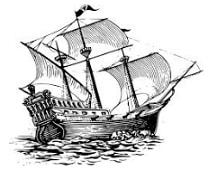Before entering fully into the definition of the term galéon, we are going to know its etymological origin. In this case, we can state that it is a word that derives from Latin, specifically from “gálea”, which, in turn, emanates from the Greek “galée”.
A galleon is an ancient ship similar to a galley , usually equipped with cross sails. These boats began to be used at the beginning of the 16th century , first in wars and exploration voyages and then as merchant ships.
 Galleons were developed by the Spanish to facilitate transportation and navigation in colonial times. Thanks to the galleons, the Spanish authorities were able to explore the territories known at that time as the Indies and promote trade .
Galleons were developed by the Spanish to facilitate transportation and navigation in colonial times. Thanks to the galleons, the Spanish authorities were able to explore the territories known at that time as the Indies and promote trade .
The so-called Fleet of the Indies , which monopolized trade between Spain and the colonies, was made up of galleons that loaded spices , gold, silver and other merchandise. They usually left Veracruz ( Mexico ) and headed to Seville or Cádiz .
Beyond their importance in Spain , galleons were also manufactured in Venice , England , France , the Netherlands and other nations , each with its own characteristics.
Through historical records, there is knowledge of important galleons that, at the time, were important for commercial activity. The galleon San Diego , for example, traveled between the Viceroyalty of New Spain and the Philippines to exchange products . This ship was sunk in 1600 by pirate attacks.
In addition to that galleon, we cannot forget other equally significant ones in history. This would be the case, for example, of the San Martín galleon. It dates back to the 16th century and was built by the Portuguese although, due to different circumstances, it passed into the hands of Spain.
It is well known for the fact that it was one of the ships that made up the emblematic Invincible Armada and not only for that but also because in the Battle of the Gravelines, where the English destroyed the Spanish fleet, it managed to emerge unscathed and returned to Spain.
It was 35 meters long, weighed 1,000 tons and had a beam of 10 meters. To all this we must add that it had 48 cannons and that its crew was made up of 160 sailors and a total of 308 soldiers.
Golden Hind , on the other hand, was a British galleon that toured much of the world between 1577 and 1580 . With the privateer Francis Drake as captain, it was formerly known as Pelican , although it was later renamed.
Given the impossibility of having complete ancient galleons, ships that imitate these vessels have often been built. The galleon Andalucía , designed by Ignacio Fernández Vial with the sponsorship of the Junta de Andalucía , reproduces a 17th century vessel and was launched in 2010 .
In the same way, it is interesting to know that for the filming of the film “Pirates”, directed by Roman Polanski in 1986 and starring Walter Matthau and Damien Thomas, the construction of a large galleon was carried out. Given its spectacular nature, it was decided not to destroy it but to display it. Precisely for this reason, today it can be enjoyed in the port of the Italian city of Genoa.
